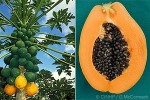Cook Islands Biodiversity Database
Species Page
Carica papaya
NītāPawpaw
Multimedia & Additional Resources
| Type | Description | Download |
| Solo variety (hermaphrodite) and fruit | 69KB | |
| Traditional variety - female and male trees | 78KB | |
| Male and female flowers | 72KB |
General Information
Cook Islands Distribution
| Southern Group: Present Makatea: Present | ||||||||
RR |
MG |
AT |
MK |
MT |
AK |
PL |
TK |
MN |
++++ |
++++ |
++++ |
+++ |
++? |
+++ |
P |
+L |
|
| Northern Group: Present | |||||
TN |
MH |
RK |
PK |
NS |
SW |
+++ |
++? |
++? |
+ |
P |
P |
Pests & Hosts
| Relationship | Pests |
| Pathogen | Colletotrichum gloeosporioides, Papaya ringspot virus, |
Scientific Taxonomy
Carica papaya Linnaeus
SYNONYMS: Papaya vulgaris
TAXONOMY: PLANTAE; ANTHOPHYTA (=Angiospermae); MAGNOLIOPSIDA (=Dicotyledones); DILLENIIDAE; Violales; CARICACEAE
More Information
IDENTIFICATION: Short-lived tree to 10m. STEM straight, stout, unbranched, scarred and hollow. LEAVES terminal cluster, massive, to 70cmØ, round, deeply palmately dissected into 5-7 lobes which are also lobed; stalk round, hollow, long to 100cm. FLOWERS traditional form separate male and female trees; male flowers on long, branching structure; female 1-3 in leaf axil, short stalked, petals white; recent forms hermaphrodite flowers similar to female flowers. FRUIT round, oblong or pear-shaped, to 45cm long, green ripening yellow-orange; flesh yellow, orange or red; seeds numerous, black, round, small.
GENERAL NOTE: An ancient development of native Americans, probably starting in Mexico, although it is not known in the wild. First introduced to Europe and Asia by the Spanish under the name papaya or papaio. Britain and most of its colonies took the name Papaw or Pawpaw. The USA adopted the Spanish Papaya, applying the name Pawpaw to a native fruit tree in the Soursop family.
It arrived in the Society Islands in 1772 on Spanish frigate Aguila, and in Rarotonga with Tuamotu canoeists before the Missionaries arrived. The Tuamotu name Nīnītā was used until its recent contraction to Nītā. On the Outer Islands it is called Vī Puaka, ‘pig mango’, except Aitutaki where it is Vīnītā, ‘pawpaw mango’.
Early varieties had very poor keeping qualities, and exportation became possible with the development of several strains of Solo Papaya in Hawaii in the 1960s. Since the opening of the Rarotonga International Airport in 1973 the local export industry has focused on the Waimanalo strain of the Solo.
The white sap of unripe fruit has about 2% of a protein digesting enzyme, papain, and elsewhere the sap is dried to a powder with many uses, including tenderising meat, making beer and cheeses, and processing wool and silk. The slices of green-ripe fruit, which still has high levels of papain, or the white latex, are locally used to treat stings, sores, boils, and fungal infections. It is also cooked as a vegetable or mashed as a health drink. Pregnant women should avoid ripe-green fruit because it has a contraceptive function that can also cause an abortion. The ripe fruit, low in papain, is very rich in Vitamin A and C. The leaves are used to maintain the freshness of flowers and the Seagrape Seaweed (Rimu).
Vouchers & References
Vouchers:
Pukapuka: fieldspecimen, 2/2004, rare, destroyed by Spiralling Whitefly, ID GMcC.
References:
p.497 Wagner et al.- Flowering Plants of Hawaii
p.600 Neal - In Gardens of Hawaii
p.210 Royal Hort. Soc. Index of Garden Plants
p.459 Tropica
p.2/672 A.C.Smith - Flora Vitiensis Nova
p.281 R* Cheeseman - Flora of Rarotonga
p.77 * Wilder - Flora of Rarotonga
p.383b Whistler - Ethnobotany of the Cook Islands
Data Update History (information):
zTX, zB02, zM02, zD02
Web Resources
Citation Information
McCormack, Gerald (2007) Cook Islands Biodiversity Database, Version 2007.2. Cook Islands Natural Heritage Trust, Rarotonga. Online at http://cookislands.bishopmuseum.org. ![]()
Please refer to our use policy.

